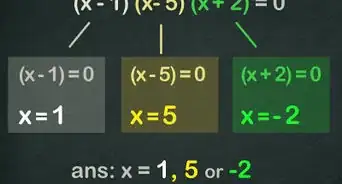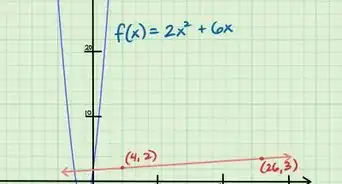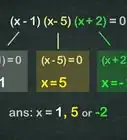X
wikiHow is a “wiki,” similar to Wikipedia, which means that many of our articles are co-written by multiple authors. To create this article, volunteer authors worked to edit and improve it over time.
This article has been viewed 83,465 times.
Learn more...
An asymptote of a polynomial is any straight line that a graph approaches but never touches. It can be vertical or horizontal, or it can be a slant asymptote – an asymptote with a slope.[1] A slant asymptote of a polynomial exists whenever the degree of the numerator is higher than the degree of the denominator.[2]
Steps
-
1Check the numerator and denominator of your polynomial. Make sure that the degree of the numerator (in other words, the highest exponent in the numerator) is greater than the degree of the denominator.[3] If it is, a slant asymptote exists and can be found. .
- As an example, look at the polynomial x^2 + 5x + 2 / x + 3. The degree of its numerator is greater than the degree of its denominator because the numerator has a power of 2 (x^2) while the denominator has a power of only 1. Therefore, you can find the slant asymptote. The graph of this polynomial is shown in the picture.
-
2Create a long division problem. Place the numerator (the dividend) inside the division box, and place the denominator (the divisor) on the outside.[4]
- For the example above, set up a long division problem with x^2 + 5x + 2 as the dividend and x + 3 as the divisor.
Advertisement -
3Find the first factor. Look for a factor that, when multiplied by the highest degree term in the denominator, will result in the same term as the highest degree term of the dividend. Write that factor above the division box.
- In the example above, you would look for a factor that, when multiplied by x, would result in the same term as the highest degree of x^2. In this case, that’s x.Write the x above the division box.
-
4Find the product of the factor and the whole divisor. Multiply to get your product, and write it beneath the dividend.
- In the example above, the product of x and x + 3 is x^2 + 3x. Write it under the dividend, as shown.
-
5Subtract. Take the lower expression under the division box and subtract it from the upper expression. Draw a line and note the result of your subtraction underneath it.
- In the example above, subtract x^2 + 3x from x^2 + 5x + 2. Draw a line and note the result, 2x + 2, underneath it, as shown.
-
6Continue dividing. Repeat these steps, using the result of your subtraction problem as your new dividend.
- In the example above, note that if you multiply 2 by the highest term of the divisor (x), you get the highest degree term of the dividend, which is now 2x + 2. Write the 2 on top of the division box by adding it to first factor, making it x + 2. Write the product of the factor and the divisor beneath the dividend, and subtract again, as shown.
-
7Stop when you get an equation of a line. You do not have to perform the long division all the way to the end. Continue only until you get the equation of a line in the form ax + b, where a and b can be any numbers.
- In the example above, you can now stop. The equation of your line is x + 2.
-
8Draw the line alongside the graph of the polynomial. Graph your line to verify that it is actually an asymptote.
- In the example above, you would need to graph x + 2 to see that the line moves alongside the graph of your polynomial but never touches it, as shown below. So x + 2 is indeed a slant asymptote of your polynomial.
Advertisement
Community Q&A
-
QuestionWhere did the two polynomials come from?
 TechnistCommunity AnswerThe (x^2 + 5x + 2) / (x+3) is part of an example. It is possible to tell that there will be a slant asymptote because the polynomial in the numerator has a degree than the polynomial in the denominator. With this in mind, you can make up as many problems or examples as you want.
TechnistCommunity AnswerThe (x^2 + 5x + 2) / (x+3) is part of an example. It is possible to tell that there will be a slant asymptote because the polynomial in the numerator has a degree than the polynomial in the denominator. With this in mind, you can make up as many problems or examples as you want. -
QuestionWhat does the remainder, once you've divided, mean in terms of the asymptote?
 Community AnswerIt represents the vertical distance between the curve and the asymptote. It should approach zero as |x| approaches infinity. You might investigate whether the remainder is positive or negative, since that tells you whether the curve approaches the asymptote from above or from below.
Community AnswerIt represents the vertical distance between the curve and the asymptote. It should approach zero as |x| approaches infinity. You might investigate whether the remainder is positive or negative, since that tells you whether the curve approaches the asymptote from above or from below.
Advertisement
References
- ↑ https://www.mathsisfun.com/algebra/asymptote.html
- ↑ https://www.purplemath.com/modules/asymtote3.htm
- ↑ http://www.softschools.com/math/calculus/finding_slant_asymptotes_of_rational_functions/
- ↑ http://www.softschools.com/math/calculus/finding_slant_asymptotes_of_rational_functions/
- http://www.sagemath.org/calctut/slantasymp.html
- http://cnx.org/content/m13608/latest/
About This Article
Advertisement


































































